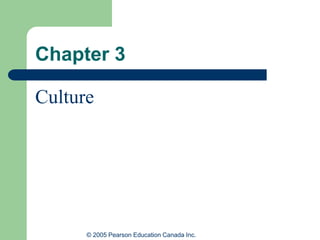Contenu connexe
Similaire à ppt_ch03.ppt (20)
Plus de Maqbool Ahmad (14)
ppt_ch03.ppt
- 2. © 2005 Pearson Education Canada Inc.
What is Culture?
Culture is the
values,
beliefs,
behaviour, and
material objects
that together form a people’s way of life.
- 3. © 2005 Pearson Education Canada Inc.
Culture Terms
Nonmaterial culture: The intangible world of
ideas created by members of a society
Material culture: The tangible things created by
members of a society
Culture shock: Personal disorientation when
experiencing an unfamiliar way of life
(Cont’d)
- 4. © 2005 Pearson Education Canada Inc.
Culture Terms (Cont’d)
Culture is very recent
– Homo sapiens 40 000 years ago
– “Civilization” 12 000 years ago in Middle East
– Industrial way of life 300 years ago
Nation: political entity and people
State: political entity in a territory with borders
Society: People who interact in a defined territory
and share culture
- 5. © 2005 Pearson Education Canada Inc.
Components of Culture
Symbols: Anything that carries a particular
meaning recognized by people who share a culture
Language: A system of symbols that allows people
to communicate with one another. Other species
may have culture, but language skills are limited.
Cultural transmission: process of passing on
culture to the next generation.
(Cont’d)
- 6. © 2005 Pearson Education Canada Inc.
Components of Culture (Cont’d)
Sapir-Whorf hypothesis: people perceive the
world through the cultural lens of language.
Values: Culturally defined standards by which
people assess desirability, goodness, and beauty and
that serve as broad guidelines for social living
Beliefs: Statements that people hold to be true
(Cont’d)
- 7. © 2005 Pearson Education Canada Inc.
Components of Culture (Cont’d)
Norms: Rules and expectations by which society
guides the behaviour of its members
– Mores: Norms that are widely observed and have great
moral significance, e.g., no sexual relations with children.
– Folkways: Norms for routine or casual interaction,
e.g., proper dress.
– Social control: means by which members of a society
encourage conformity to norms.
- 8. © 2005 Pearson Education Canada Inc.
“Ideal” and “Real” Culture
IDEAL CULTURE
– The way things should be
REAL CULTURE
– The way things actually are
- 9. © 2005 Pearson Education Canada Inc.
Material Culture and Technology
Technology: knowledge that a society applies to the
task of living in a physical environment
Humans in original state had little more than simple
tools
In Canada, some groups reject modern technology.
New Information Technology: The application of
ideas and information using computers and other
electronic devices, began 50 years ago. It can
generate culture on a grand scale.
- 10. © 2005 Pearson Education Canada Inc.
Cultural Diversity
Multicultural: 2001 Census had more than 200
responses to question of ethnic identity in Canada
High Culture: Cultural Patterns that distinguish a
society’s elite
Popular Culture: Cultural patterns widespread
among society’s population
(Cont’d)
- 11. © 2005 Pearson Education Canada Inc.
Cultural Diversity (Cont’d)
Subculture: Cultural patterns that set apart some
segment of society.
Multiculturalism: Social policy designed to
encourage ethnic or cultural heterogeneity.
Eurocentrism: dominance of European cultural
patterns
Counterculture: Cultural patterns that strongly
oppose those widely accepted
- 13. © 2005 Pearson Education Canada Inc.
Cultural Diversity (Cont’d)
Cultural Change: Occurs by invention, discovery,
and diffusion
Cultural lag: Some elements change more quickly
than others
Ethnocentrism: Practice of judging another culture
by the standards of one’s own culture
Cultural Relativism: Practice of evaluating a
culture by its own standards
- 14. © 2005 Pearson Education Canada Inc.
A Global Culture?
Societies have more contact by the flow of:
1. goods
2. information
3. people
But these flows are uneven:
the goods and services are expensive; and
different meanings are attached to them
- 15. © 2005 Pearson Education Canada Inc.
Structural-Functional Analysis
Culture is a complex strategy for meeting human
needs
– Cultural Universals: traits that are part of every
known culture and include: family, funeral rites,
& jokes
Critical evaluation: downplays importance of
change, and overlooks range of diversity.
- 16. © 2005 Pearson Education Canada Inc.
Social-Conflict Analysis
Culture is a dynamic arena of conflict.
Cultural traits benefit some members at the
expense of others.
Approach rooted in Karl Marx and materialism –
society’s system of material production has a
powerful effect on the rest of a culture.
Critical evaluation: Understates the ways cultural
patterns integrate members into society.
- 17. © 2005 Pearson Education Canada Inc.
Cultural Materialism
A paradigm that explores the relationship of human
culture to the physical environment.
Why do Hindus not eat cows?
Cows cost little to raise and produce oxen and
manure, the latter providing building materials and
a source of heat.
Critical evaluation: not easy to draw connections and
modern society can manipulate the natural world.
- 18. © 2005 Pearson Education Canada Inc.
Sociobiology
A theoretical paradigm that explores ways in which
human biology affects how we create culture.
Approach rooted in Charles Darwin’s concept of
natural selection: living organisms change over
long periods of time.
Critical evaluation: May be used to support racism or
sexism; and little evidence to support theory, people learn
behaviour within a cultural system.
- 19. © 2005 Pearson Education Canada Inc.
Culture and Freedom
Culture as constraint
– We only know our world in terms of our culture
Culture as freedom
– Culture is changing and offers a variety of
opportunities

